Germany is the land of Castles and Palaces, where many fairytales, movies and even Disneyland got inspiration to share stories about love, kings, battles, and princesses.
Traveling around Germany gives, the opportunity to visit beautiful castles, palaces and old fortresses in cities full of tourists or in very quiet forests. Castles and palaces can be visited through all the year and they will have a different charming with the change of seasons. In spring and autumn, nature displays the most beautiful colors, but is also great to visit Germany during the Christmas season in December, where cities are beautifully decorated!
Most of the travelers can visit Germany without a visa, thanks to the Schengen arrangements, so if you are from Chile, Argentina, the U.S. or several other countries you can visit this area for up to 90 days!
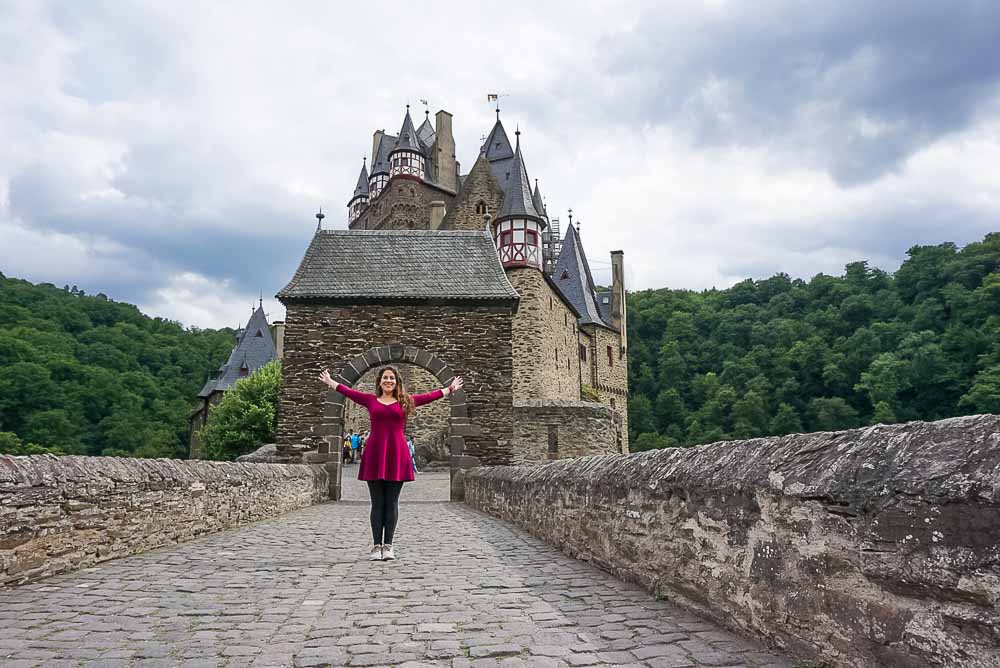
German Medieval castles come from an era when kings and ruling families lived there and the architecture was strategically made to protect them.
Some of these castles are still owned by the original family and where the place they were living until not so long time ago. Today they are popular destinations for sightseeing, hosting restaurants, hotels, even wedding receptions, and other special events.
The German Castle Club estimates there are above 25,000 castles in the country, most of them are in ruins or only having their foundations, and only about 20% of them are still having a roof.
There are four palaces recognized as UNESCO World Heritage site. If you are interested in a full list of castles you can check this list of all the castles in Germany by region.
In German, castles are called “Burg” and palaces “Schloss” and you will constantly see these words while reading your favorite travel guide through Germany.
If you are searching for some travel inspiration in Germany, these are some of the favorite Castles and Palaces to visit in Germany for experienced travelers and their reasons for you to visit them.
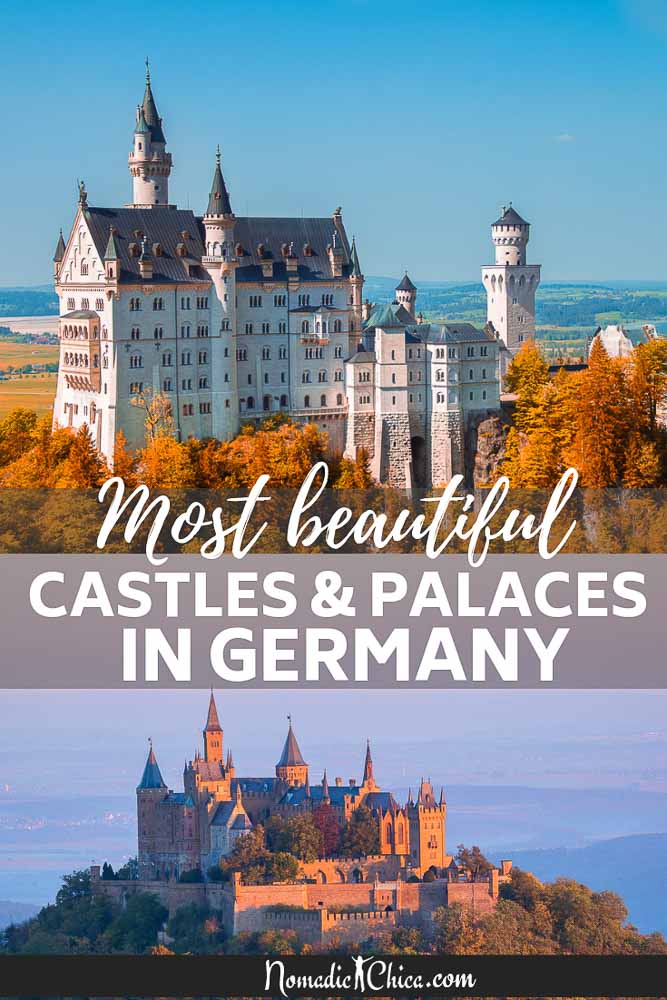
1. Burg Eltz, Mosel Region
by Gloria from Nomadicchica
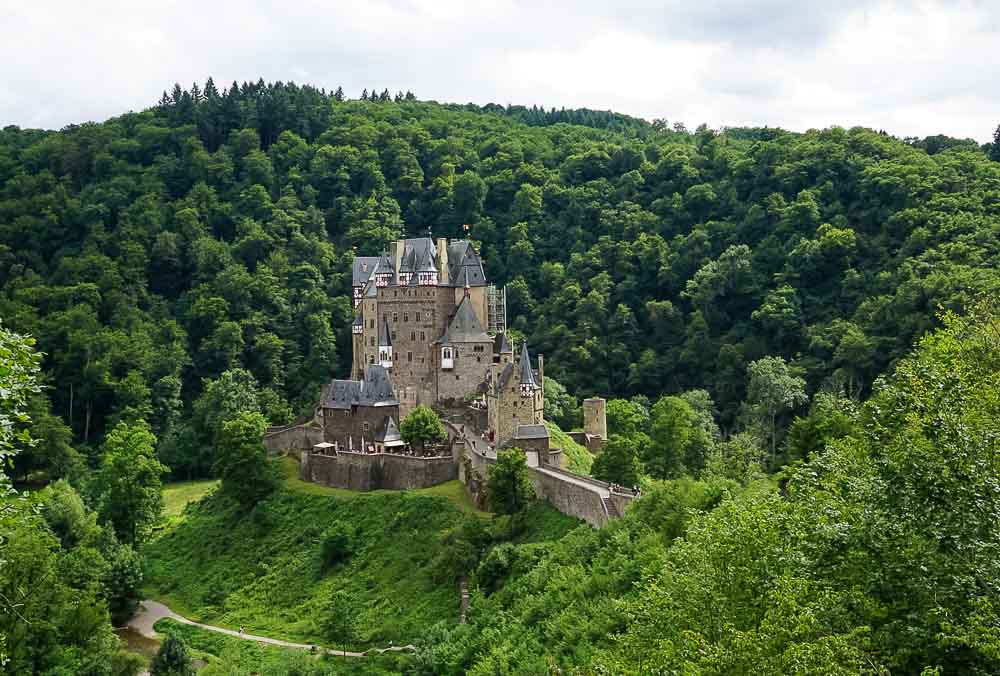
This is one of my own favorite castles to visit in the Mosel region. When you head there the view of the castle from the distance it will be close to your childhood dreams, located on top of a mountain, with eight tall towers and green fields around.
Its location is inside the Eltz forest, to reach the Medieval castle you can enjoy a beautiful hike surrounded by big trees and a lot of silence. It was built to secure the trade route in the Mosel-Maifeld-Eifel area.
Eltz Castle is one of the three castles on the left bank of the Rhine River still having the same architecture as it remained untouched by wars.
It was built during 500 years in the 12th century and owned by the same family for over 850 years until today. The owner today lives in Frankfurt am Main, Dr. Karl Graf von und zu Eltz-Kempenich, alias Faust von Stromberg.
The Eltz Castle exhibition includes Armoury and Treasury elements and it’s one of the most important private collections, holding more than 500 exhibits from 8 centuries including remains of Celtic and Roman fortifications on the site. With over 100 rooms for family members, staff, and guests, some items displayed include glass and porcelain, jewelry, and weapons.
To get there you can go by car as a day trip a day trip from Köln, Frankfurt, Trier, Bohn, or Mainz, or by public transportation. The closest train stops are in Koblenz, Moselkern, and Karden, and you can take a bus from any town in the area. Check on their website for more detailed information.
2. Sanssouci Palace, Postdam
by Soumya, from Stories by Soumya
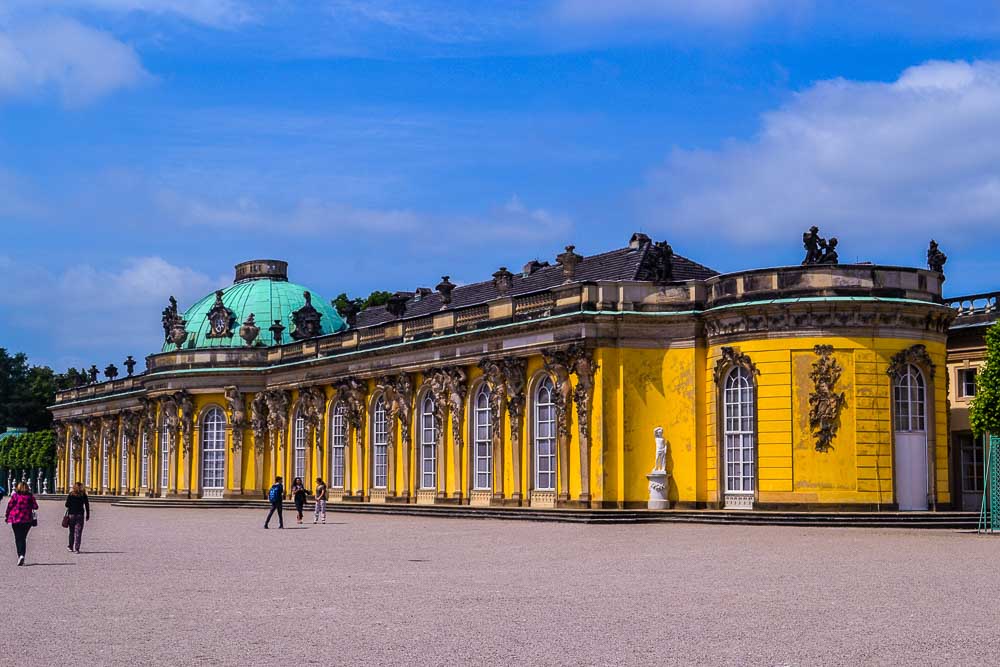
The magnificent Sanssouci Palace in Potsdam is one of the most iconic palaces of Germany.
A famed UNESCO World Heritage site, Sanssouci was built in the early 18th century to serve as a peaceful summer retreat for King Friedrich, the Great. Hence, the name Sanssouci which means “without a care” in French.
Sanssouci is a smaller palace when compared to other contemporary European palaces. However, the beauty of its interiors is breathtaking. Sanssouci is opulently carved with rich Rococo designs and ornate, floral reliefs. King Friedrich is said to have imposed a lot of his own style and taste into the rococo at Sanssouci. Eventually, this led to the birth of “Friedrichian Rococo” in Prussia. Sanssouci boasts of elegant Friedrichian Rococo designs on its ceilings and walls, the splendor of which can keep you riveted for hours.
Sanssouci also has an expansive natural park adjacent to it. The park is filled with greenhouses, manicured hedges, terraced vineyards, and imposing statues. A little further away is the Neues Palais or the New Palace of Sanssouci, an impressive Baroque-styled mansion. The Grotto Hall here is the most intriguing and eccentric.
The palaces and parks of Sanssouci in Potsdam make for a great day trip from Berlin. What is even better is that entry to all of them is included in the Sanssouci+ pass.
Potsdam is easily accessible by public transportation and car and there are some really good places to eat around.
3. Schönberg Castle, Oberwesel
by Carolyn, Holidays to Europe
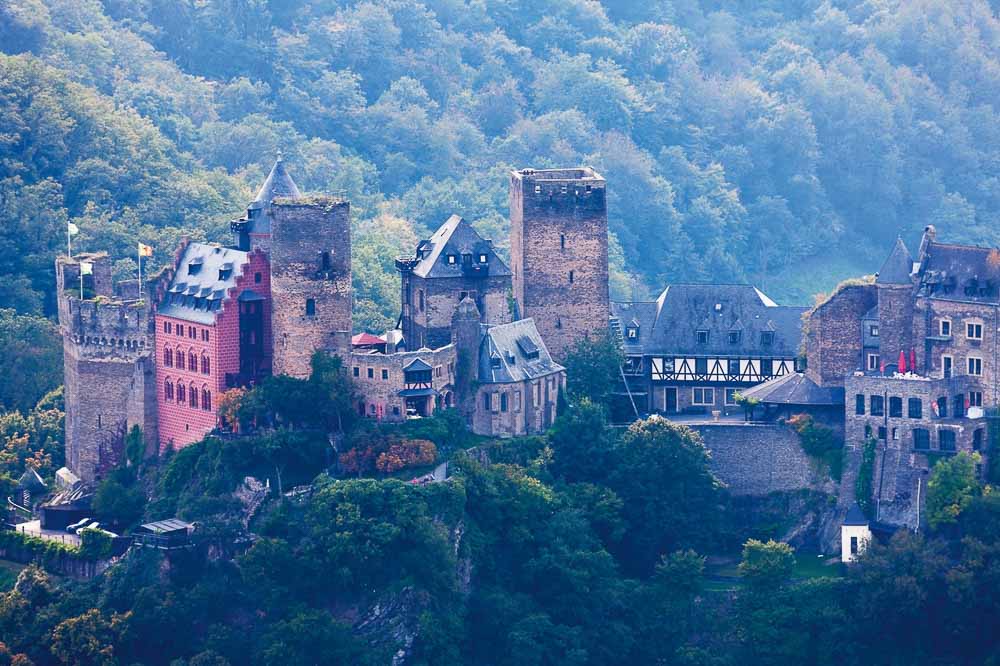
Cruising along the River Rhine in Germany, or driving alongside it, you can’t help but notice the many castles that perch on the hilltops beside the river. It seems that there is a castle every mile or two but the one that I really enjoyed visiting is Schönberg Castle.
Built on a peak above the village of Oberwesel in Germany’s Upper Middle Rhine Valley, Schönberg Castle dates back to the 12th Century. The original castle was destroyed in the late 17th Century but was rebuilt in the early 1900s when a German-American banker bought the ruined castle and restored it to its former glory.
The castle is popular with both day visitors and guests who stay overnight. Both a 4* hotel and a youth hostel are housed in Schönberg Castle so whatever your budget, you can live your own fairytale and sleep the night in a castle.
Housed in an old gate tower, the Tower Museum is worth a visit. It explains the 700-year history of Schönberg Castle and features a slingshot simulation show and an observation deck which offers superb views over the River Rhine below.
It’s from up here that the castle’s original residents kept watch for invaders and you can see why this was an excellent location for a fortress.
The highlight of my visit to Schönberg Castle was the delicious lunch I enjoyed on the restaurant terrace. On a warm summer’s day with the Rhine Valley spread out below, I couldn’t have asked for a more beautiful location.
4. Wartburg Castle, Eisenach
by Kaila from Nylon Pink
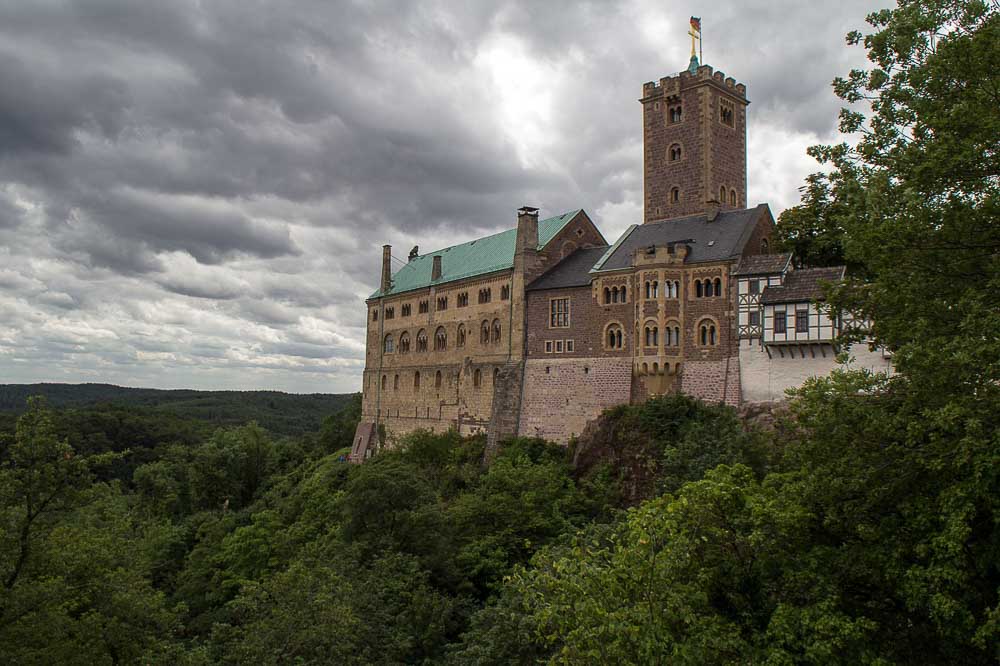
This is an amazing castle that the Germans hold near and dear to their hearts. It is a beautiful sight to behold and is medieval in every sense of the word and is located about 4 hours north of Hamburg. And best of all, it is a UNESCO World Heritage site, too. The castle was built in 1907 by Ludwig I of Thuringia and has survived to this day.
Martin Luther, the author of the 95 Theses, hid out here for a year to escape the Inquisition. Saint Elizabeth also lived there-after becoming a widow at 20, she devoted her life to helping the less fortunate. If you are musical, you have to see the beautiful Hall of the Troubadours, where a competition known as Contest of the Minstrels was held.
The setup of the room is stunning, as is Elizabeth’s Boudoir, where the vaulted chamber is covered with small glass tiles meticulously placed to form a lovely mosaic. The Banquet Hall (known as Festsaal) is another amazing spot to see, with its coffered ceilings.
You can go on a guided tour if you like, and one tour is offered each day at 1:30 PM in English, year-round. Grounds are open daily from 8:30 to 8 November through March.
5. Lichtenstein Burg, Lichtenstein
by Christine from Christine Abroad
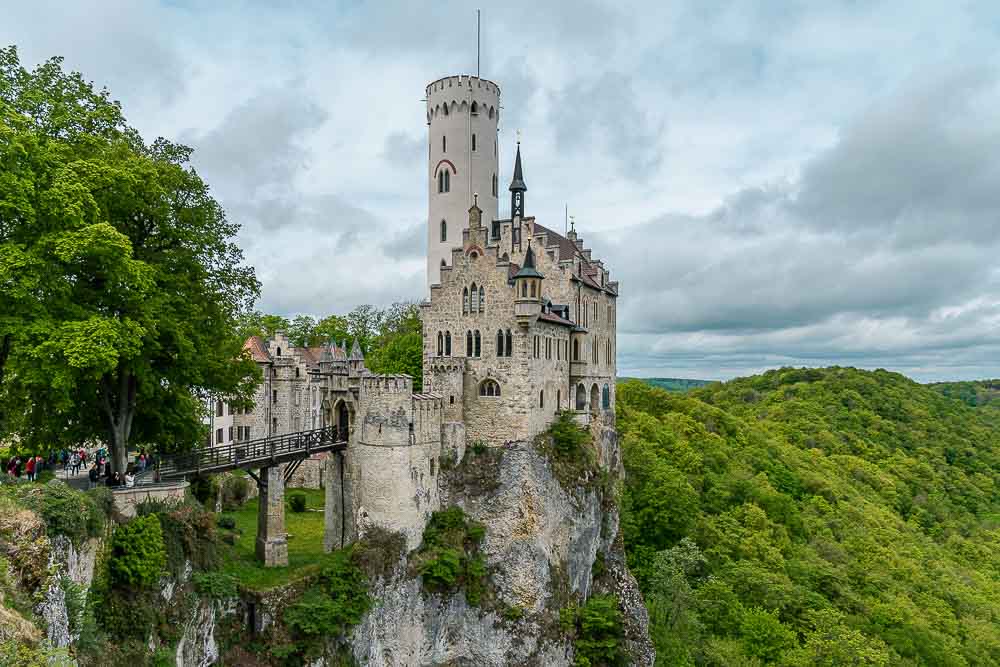
Lichtenstein Castle is one of the hidden gems in Germany. A lot of locals know about this castle, but few foreign tourists find their way here. It’s a shame because it’s truly beautiful. It’s also quite near another popular castle called Hohenzollern.
It was designed by Carl Alexander Heideloff and it has been described as the fairytale of Württemberg. The name Lichtenstein literally means shining stone.
The modern castle is not the original but was inspired by the ruins of the medieval castle, and it was built in Gothic revival style.
The easiest way to get here is by car, and there’s a big parking area next to the entrance. But, you can also go here on a guided group tour via bus.
If you want to go inside the Castle, you have to join one of the guided tours, but it’s also possible to just visit the main castle garden and get the iconic view over the castle. That costs only 2 Euro, but since you’re there, and the fact that you can see old armors, weapons and other relics inside, it’s totally worth to go inside.
Also, you will learn some more about the castle during the tour as well. From the viewpoint of the Castle, you will also get splendid views of the surrounding landscape.
6. Heidelberg Burg, Heidelberg
by Gábor from Surfing the Planet
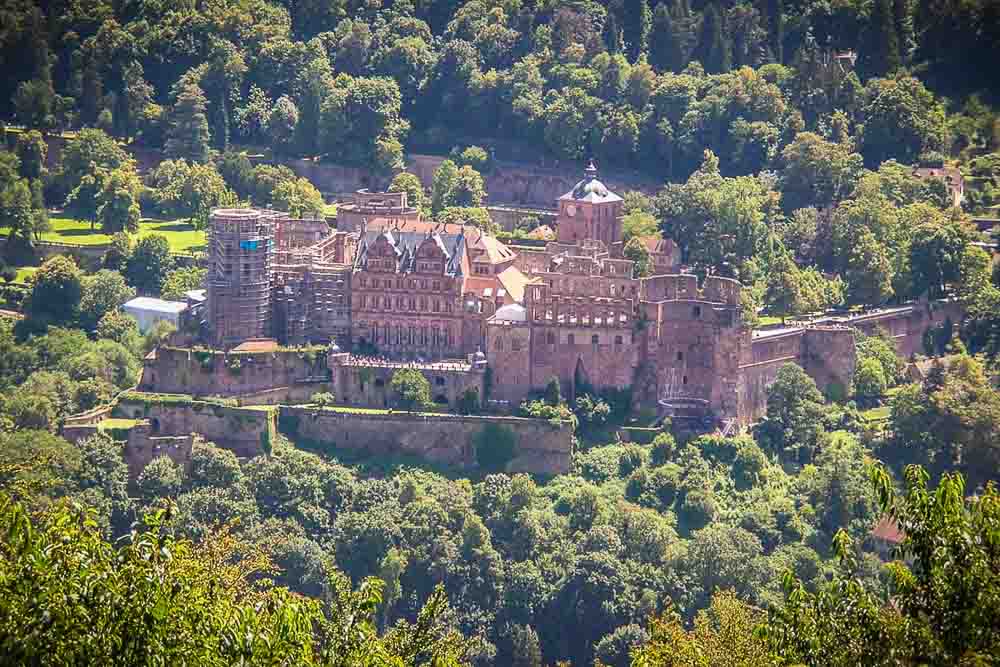
Heidelberg is known to be one of the most romantic towns in not only Germany but in whole Central Europe. Amongst the several interesting monuments to visit in Heidelberg, there’s no doubt that Heidelberg Castle is the main highlight. The castle is one of the most beautiful hilltop castles in Germany, situated on top of Koenigstuhl.
The beginning of the construction of this fabulous Renaissance Castle dates back to the 13th century, and although castle has been destroyed and rebuilt several times, it is still the most spectacular building in Heidelberg. From the city center, you can climb up to the castle or you can also take the historical funicular to get there.
Apart from the historical importance and the beauty of this castle, it’s also the best viewpoint in Heidelberg, looking down on the Old Town and the Neckar River with the Old Bridge crossing it.
There are several interesting sights to visit inside the castle complex, one of them is the German Apothecary Museum with a fascinating collection of pharmacy objects, some of them dating back several thousand years.
The other interesting visit is the wine cellar, where you will find of one of the most gigantic wine barrels you have ever seen with a capacity of over 50,000 gallons of wine. The entrance ticket to the castle includes the visit of all the latter sites.
7. Nymphenburg Schloss, Munich
by Betsy from PassingThru
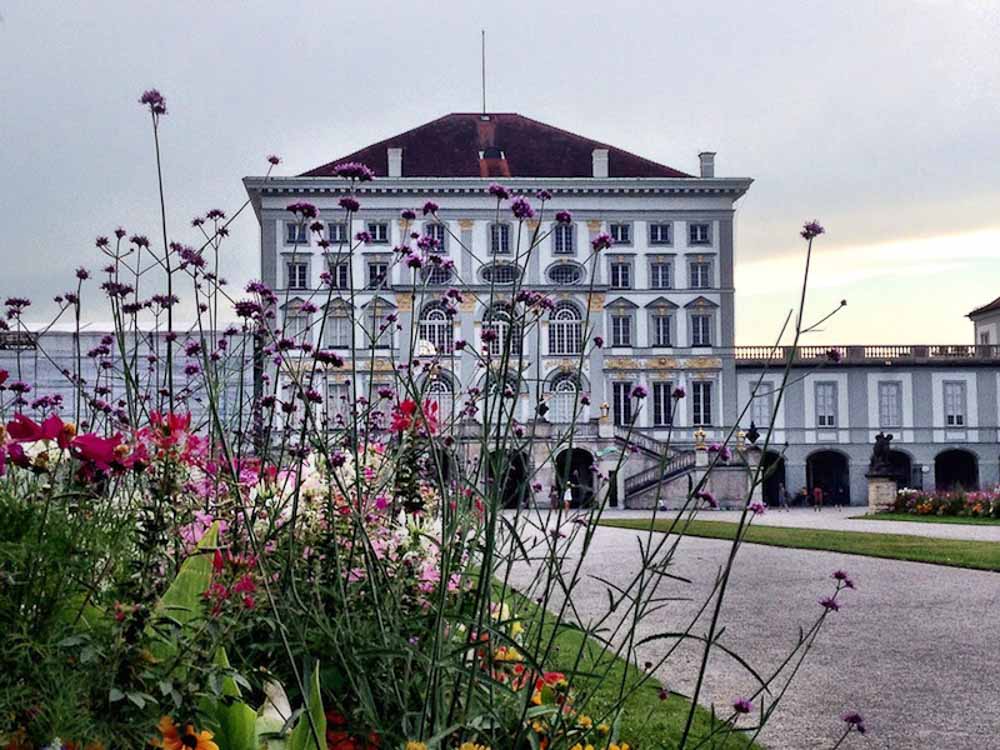
First time visitors to Munich invariably visit Schloss Nymphenburg, but what they might not expect is that the Palace complex will draw them back for new discoveries.
Begun in the 17th century as a residence from which to enjoy summer in the countryside, the Wittelsbach Bavarian Royal family subsequently expanded Nymphenburg to include gorgeous natural park and gardens, the whimsical Rococo Amalienburg building, other mini-palaces and pavilions in various styles.
The Palace’s grand stables included a “Cavaliers’ Building,” which is now the Marstallmuseum with more than 40 coaches, sleighs, and carriages, including the Coronation Coach of Emperor Karl VII and the 19th-century state coaches of King Ludwig II.
Also on the grounds is the Museum of Nymphenburg Porcelain, which is a private collection of priceless figures and artifacts dating from the 19th and early 20th centuries from the Royal Art Institute, founded by King Ludwig I.
The main palace is stunning with its Baroque pavilions, light-filled galleries, and opulent apartments, all of which are opulently painted and embellished with carvings and gilded elements.
8. Vischering Burg, Lüdinghausen
by Roxanna from Gypsy with a Dayjob
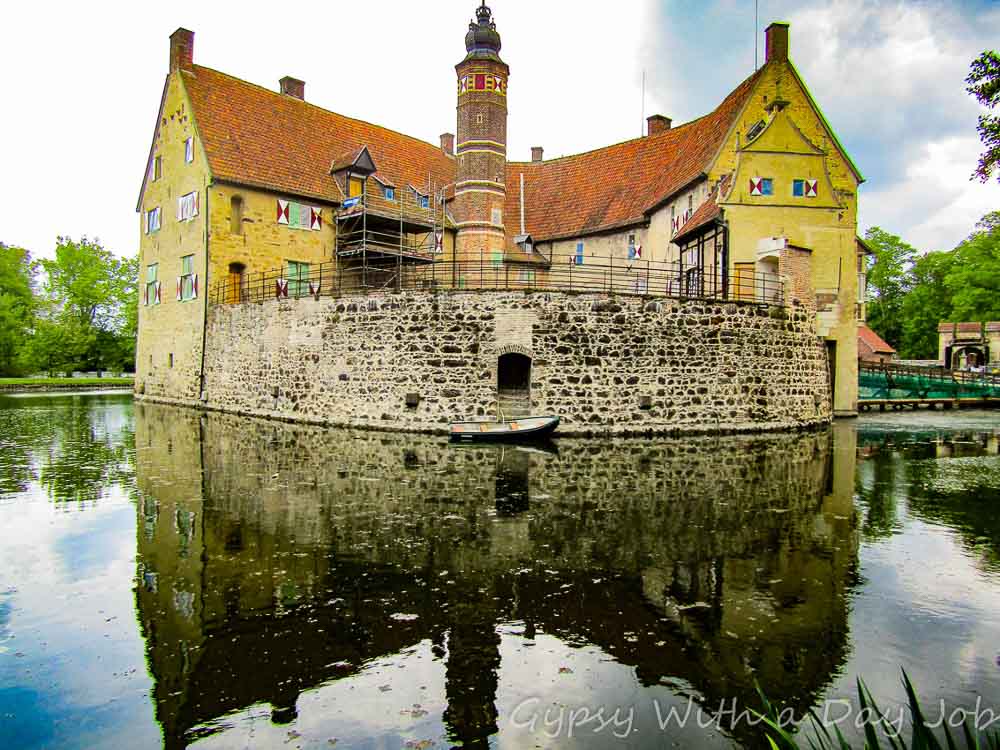
Vischering Castle was built in the year 1271, by the Catholic Church, and the Bishop of Münster, as a residence for the Droste, a noble office within the Holy Roman Empire that was passed through heredity. Wars were common, so the castle was built for strategic defense. It had thick sandstone walls, a double moat, and an outer defensive courtyard which included defensive walls, secret gateways, and shooting ranges.
If it sounds formidable, it was indeed, as the castle withstood all attacks for 250 years, however it was heavily damaged by fire in the 1500s. It was rebuilt upon the original foundation, but times were more peaceful. Additions were made to ensure a comfortable lifestyle and one which conveyed the notions of wealth and sophistication to onlookers.
The differences between the original stone and that used for the rebuilding can clearly be seen but this combination of stones, styles, and colors gives the castle an eclectic charm, that contributes to Vischering Castle being one of the most unique castles in Germany. Today, all of those defensive mechanisms present to convey a romantic notion, as the 3 stories reflect in the moat below. Burg Vischering is simple but quite beautiful.
Visitors to Vischering Castle enter through a drawbridge, with leads to the inner courtyard. The castle was recently remodeled for its 750th anniversary, so there may seem to be a fresh gleam in the historic rooms. Guided tours are available and there is a museum about medieval life, with kid-friendly knights in armor exhibit.
Visitors can also explore the grounds, or have refreshments at the bistro on the back patio-like area of the castle. There is a pleasant walkway between the moats, that is accessible, and includes informational signs about the history of the castle.
9. Wernigerode Schloss, Wernigerode in Saxony-Anhalt
by Cate from International Desserts
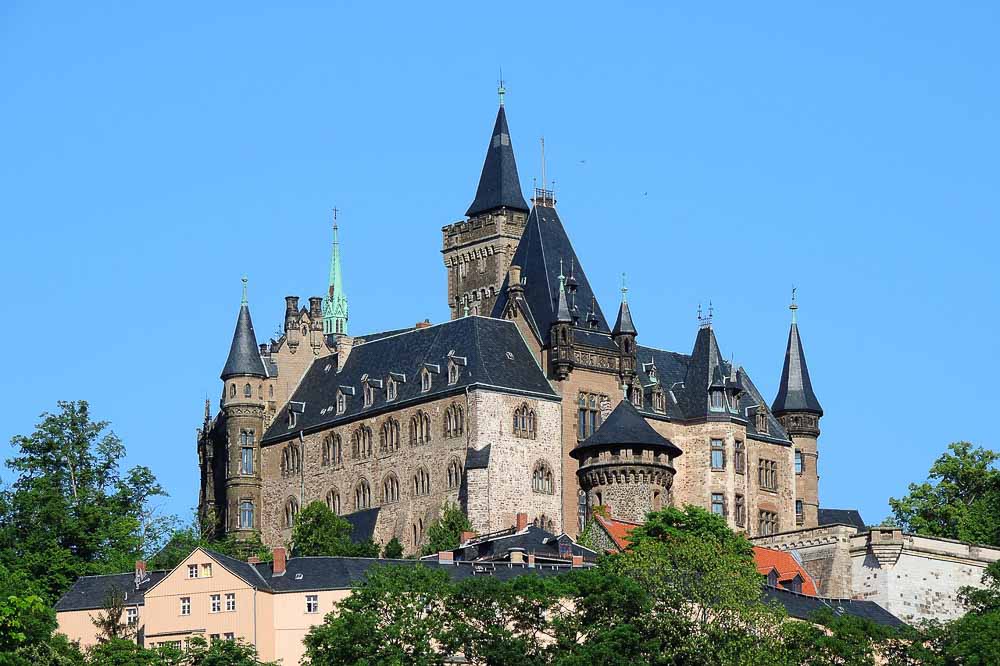
Most people immediately think of Neuschwanstein or Burg Eltz when planning which castles to visit in Germany. I did, too, until I lived in Magdeburg in eastern Germany and visited the beautiful Schloss Wernigerode in the Harz mountains.
Similar in style to Neuschwanstein, albeit smaller, this baroque style castle was once a medieval fortress. Completed in the late 19th century, it opened to tourists in the 1930s.
You can easily reach Schloss Wernigerode by foot (it’s about 1.3 miles/2.2 km from the train station) or you can take the Bimmelbahn (a cute tourist train) up the hill to the castle if you don’t want to walk.
The castle offers a couple different tours in different parts of the castle, and there are discounted rates for kids and families. While at Schloss Wernigerode, be sure to enjoy the stunning view of the town of Wernigerode below.
Once you’ve had enough castle, walk back down to the town center to take in the beautiful half-timber buildings in the market square.
If you’re looking for more things to do in the area, consider a hike in the beautiful Harz mountains or a quick trip to Quedlinburg, a cute small town that’s on the UNESCO World Heritage List and has its own castle on a hill.
10. Hohenschwangau Castle, Schwangau
by Richa from My Tickle Feet
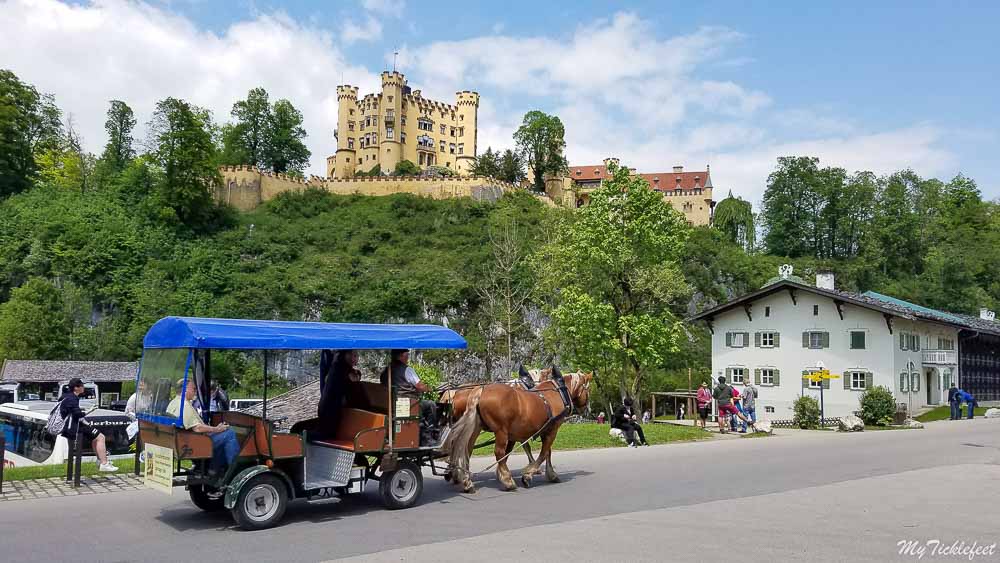
When we were planning a day trip from Munich to Neuschwanstein castle we had no idea that we will be surprised by yet another beautiful castle – Hohenschwangau – in the same vicinity. Interestingly Hohenschwangau Castle was built much before the Disney castle, Neuschwanstein, in the village of Schwangau.
It used to be the summer residence of Bavarian King Ludwig and his family when he was growing up. Located perfectly on a hilltop surrounded by the Austrian Alps and Lake Alpsee, there is no question where Ludwig found his inspiration to build the Neuschwanstein castle. Luckily this castle was spared from any destruction in World War II.
You can take a guided tour of the interior of this castle where they have preserved the royal living style from the last century. It’s advisable to buy your tickets online in advance not only to avoid long queues but also to guarantee your tour as there are limited time slots per day.
Hohenschwangau castle is a short walk up the small hill as opposed to a longer hike to its neighbor Neuschwanstein. But if you are not the one to take steps you can take a horse carriage all the way up to this castle.
The views from here are splendid especially at sunset, worth taking a stopover at Hohenschwangau castle from Munich.
11. Nuremberg Castle, Nürnberg
by Marie from Our City Travels
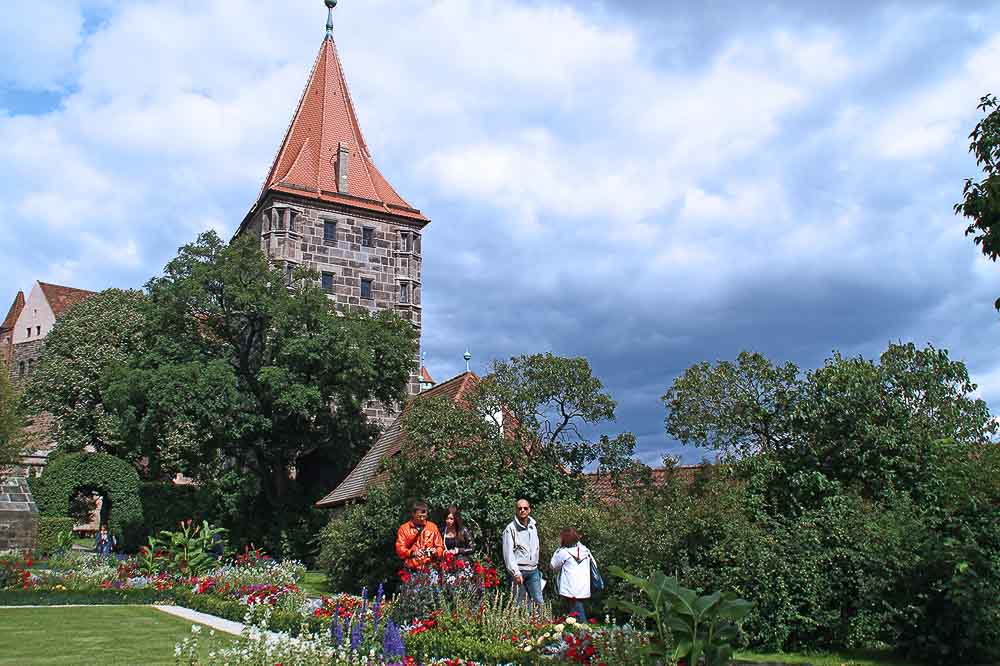
Nuremberg was one of Germany’s cities that I was able to visit multiple times. It’s medieval surrounding, and now being in the midst of an almost modern landscape really attracts me despite its history. The walled old town Altstadt) is easy to navigate and one can get a feel of the past seeing the many Fachwerkhäuser, those half-timbered houses that even the Albrecht Dürer house/museum is designed and made of.
At the northern edge of the fortifications and stone towers, surrounded by red-roofed buildings, stands the Kaiserburg (Imperial castle), the former Burg Grafenburg (Burgraves’ castle), and the Reichsstädtische Bauten (buildings erected by the Imperial City) at the eastern site comprising all of Nuremberg castle.
Going up the castle needs good stamina, the outer courtyard is uphill, which means most areas of the castle needs to be climbed up. In the middle of the courtyard is the deep well which is as old as the castle itself, being the only source of water for the castle’s residents. Walking inside, one would be welcomed in the inner courtyard which today remains walls of sandstones and cobblestone pathways.
There is a chapel, some towers and if you go up high, there’s a garden in the middle where greens abound. It is a sort of sanctuary to those with tired feet. It is also a wonderful standpoint to view the whole of the old town and Nuremberg’s skyline.
12. Hohenzollern castle
by Leo from Safari Nomad
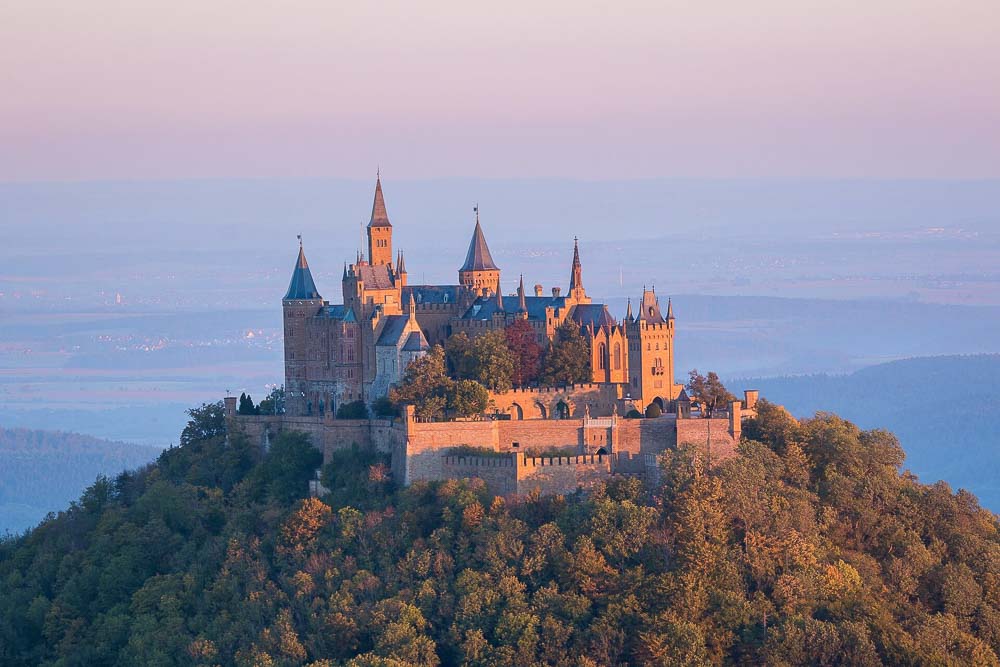
The Hohenzollern castle is the largest castle in southwestern Germany and one of the most visited in Germany. Situated in the hilltop of a beautiful mountain in Swabia region, distant about 50 km from Stuttgart.
The original Hohenzollern fortress from the 11th century was destroyed and rebuilt in the 1600’s. It was the property of the Imperial House of Hohenzollern and important site in Prussian history, where the family never lived, but used only as a place for majestic parties.
Approaching the castle, it is visible from miles away and it looks like in fairy tale. But when you come closer, it’s neo-gothic style is simply impressive.
The magnificent interior rooms of the castle will leave you speechless, you can really appreciate the royal influence. With a help of a tour guide, you will enjoy a journey through German history and the Hohenzollern ancestral seat. Many precious things can be seen there, such as the family tree of the owners painted on the walls of the entrance room, golden chandeliers with candles, Prussian king’s crown with its 142 diamonds.
In addition to the children’s and family tours, there are also various events, such as open-air cinema, theatre, shooting star nights, Royal Christmas market, Hohenzollern Mountain race, and others. Also in the region, there are popular hiking trails that are worth to consider if you want to spend time in nature.
You can get there by taking a train from Stuttgart to Hechingen, then taking a bus to the Hohenzollern parking lot and then hike 20 minutes to the top.
13. Neuschwanstein, Schwangau
by from Swedish Nomad
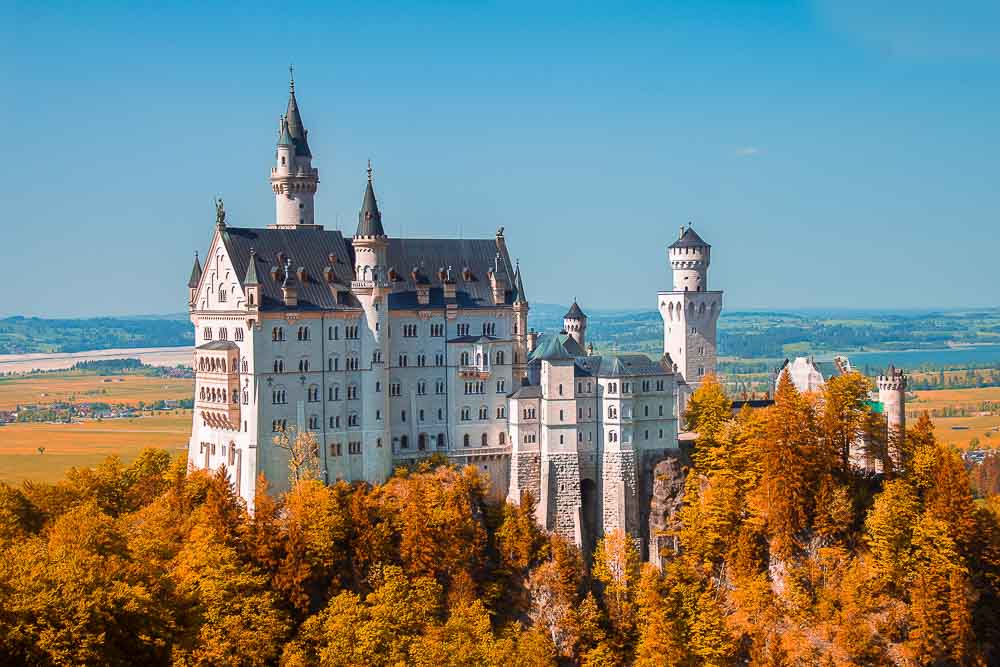
Neuschwanstein is the castle of all castles and receives more than 1.3 million visitors each year! It was built by King Ludwig II in the 1800’s and has since inspired the fairytale castles of Disney. Neuschwanstein is often mentioned as a castle, but in reality, it’s a palace since it never was intended to withhold against attacks. It was purely built as the residence of King Ludwig II of Bavaria.
It’s strikingly beautiful both on the inside and outside. Neuschwanstein is located at a hilltop in Schwangau, in the region of Bavaria. It’s the most visited attraction in all of Bavaria, and you can get here easily from nearby cities such as Münich and Innsbruck. I recommend to travel here by car, but you can also go by bus or train, or join a guided tour.
All in all, Neuschwanstein is one of those places everyone should visit at least once in their life!
From the bus stop, you walk uphill for about 30 minutes. And if you’re feeling lazy, it’s possible to go for a shuttle bus ride as well. The viewpoint is a point of interest that shouldn’t be missed. It’s called Marienbrucke, and it’s from there you get the iconic view over the castle.
I suggest buying tickets before you travel there unless you stay overnight. Because the tickets sell out quickly, and you’re only allowed to enter the castle on a guided tour. You can buy them online and you need to do it a minimum of 3 days before your arrival.
14. Bad Muskau, Muskau
by Anna from My Travel Scrapbook
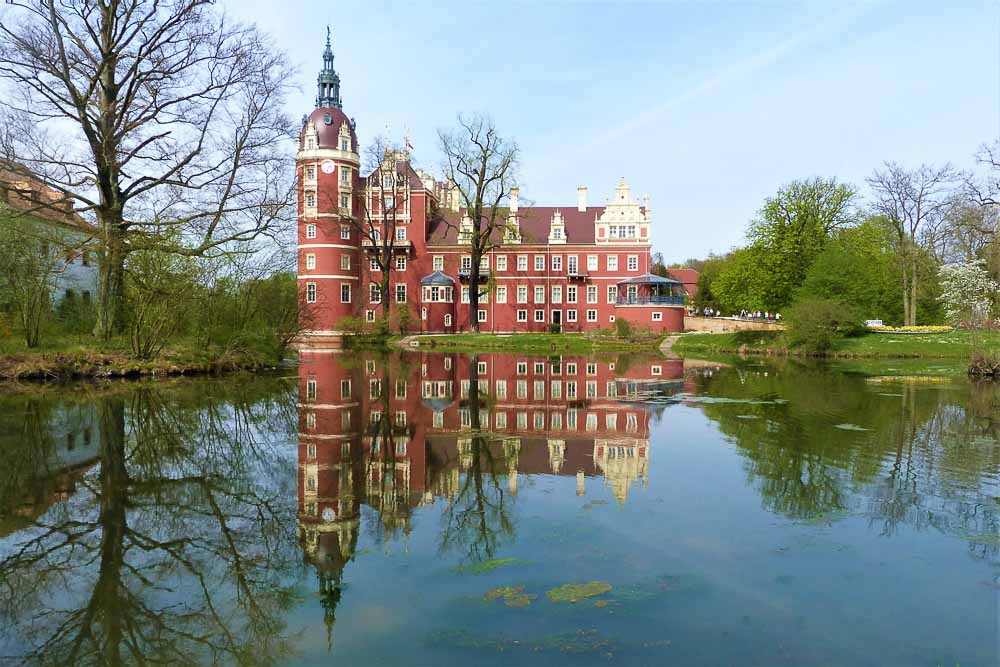
“Am I still in Germany?” I asked myself as I stepped into the lush green park of Bad Muskau. It felt more like a grand English country house estate, straight out of a scene from Downton Abbey. Indeed, a kind of English atmosphere was exactly what the designer wished to encapsulate.
The eccentric Prince Hermann Ludwig Heinrich von Pückler-Muskau was the ambitious project manager of Bad Muskau.
The count wanted to create the perfect 19th century English garden. His determination was so steadfast that he altered the course of the Neisse, the winding river which runs through the park and moved an entire village. He would stop at nothing, including asking gardeners to move trees if he was not happy with their position. Of course, all of this came at a cost and Pückler was a notorious gold digger when choosing wives to gain the necessary funds for his Bad Muskau paradise. His finished design included a rather pink castle complete with baffling figurines perching on its many turrets.
Bad Muskau is on the German/Polish border, a perfect day trip from Dresden. After World War II the area was altered significantly once more. The park was divided as the River Neisse was the official border between the two countries. For years the park lay in disarray due to the new political border.
After German reunification, Poland and Germany worked together to restore Bad Muskau to its former glory. Bad Muskau stands proudly once again and is one of the few UNESCO sites which straddles two countries.
Hire a bike for the day and explore the lovely grounds around the castle. Start in the traditional English park on the German side then cycle over the river Neisse to explore the wilder woodland on the Polish side. The English bridge connects the two parts of the park creating a wonderful cross-country collaboration.
After you have finished admiring Saxony’s pink castle you can cycle to the nearby Devil’s bridge in the Rhododendron gardens to gaze upon a truly spectacular site. Enjoy a perfect day of cycling and exploring Bad Muskau Castle.
Are we missing your favorite castle? Tell us about it in the comments below!
















0 Comments